

| Home | For sale | Site map | Contact information | Guest book | Mauser slings page 1 | Mauser slings page 2 | Mounting instructions |


 Mauser
slings, part 2 Mauser
slings, part 2 
|
|---|
| Welcome
to part 2 of my Mauser sling article. If you arrived directly here, please click here to go to part 1 first to get some continuity Copy, surplus,
fantasy, fake or
the real deal?
How to tell them apart? There is a lot of slings for the Mauser K98k offered for sale on Ebay, various forums, Facebook and by the different militaria dealers out there, but to maneuver safely in to harbor, one needs to understand the dynamics of the game. If everything was black and white it would have been easy, but unfortunately there are a lot of shades of grey... Copy slings 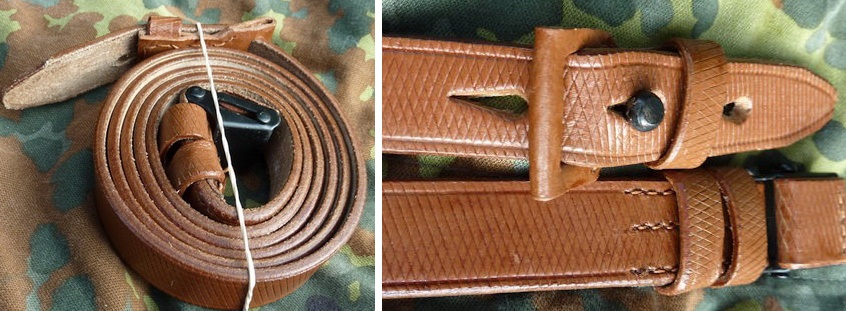 Copy slings are newly manufactured. Most of the time these are made to be usable substitutes, not meant to fool a collector. Check out the slings offered by IMA and see what you think. Copy slings are of course brand new, and will take a lot of use to look convincing in my eyes. Surplus slings Surplus slings are manufactured by any nation to fill a demand for replacements for the postwar use of the K98k. The K98k was used extensively by many nations after 1945, including Israel, Norway, Austria and Yugoslavia. The Norwegian slings (above) are easily recognized by a "fake" stitching running along both edges pressed into the leather, and no ricasso pattern. Easy to spot when they are brand new, but might fool the inexperienced when it is well used. Yugoslavia even started up production of their own version, the Mauser M48. The danger with surplus slings is that they can have seen any degree of use and look rather convincing. But they will always be differing in details, materials and production techniques. A buckle or a stopper with "BK" inside a circle is postwar Yugo made. A "K" halfway outside a circle on a buckle is Hebrew, and Israeli made. If the buckle is made of brass, it isn't German WW2. The Germans only used brass for the stopper, and that was discontinued by 1937. Some postwar made surplus slings also utilize a brass stopper though. If you find a buckle with markings not on the list, it isn't German WW2. 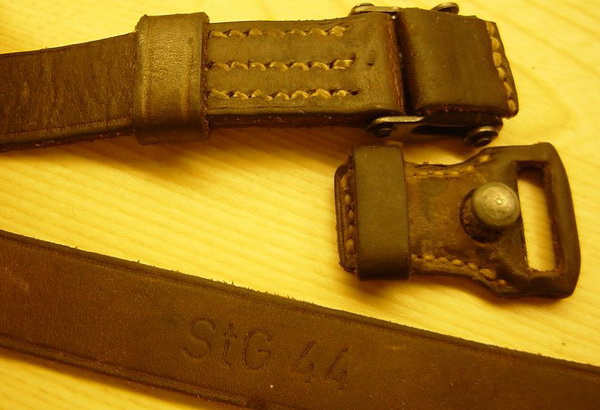 The above sling is a typical surplus sling, but country of origin is unknown. It has the typical postwar fat leather and absolutely no trace of any ricasso pattern. The actual cut, hardware and sewing is very close to the original, but the seller has beefed it up with a fantasy marking to increase the "sellabillity". This stamp is a dead-giveaway for lack of authenticity. Fantasy slings Fantasy slings are just that, so the term "copy" doesn't really fit. A well-known fantasy product is the web sling for the K98k. Same goes for web slings for every single other German WW2 made weapon as well, with two exceptions that I know of. The Panzerschreck weapon system had a web sling that was permanently attached. In addition, the Volksgewehr (VG) series of handguns frequently used web slings. They will be described further down. Today, unscrupulous dealers offer MG42, MP40, G43 and K98k slings in web, often adorned by fake ink stamps. Some of these are new made copies, while others are surplus slings for who knows what. Some of the surplus slings even reuse the original hardware.  The sling above is found marked with G43, K.43, K98k and Stg44. This model has been frequently offered on Ebay over the years. It does resemble some of the original slings used on the VG series, but again the marking is a dead giveaway. All the types of guns it can be found marked for used a Karabinerriemen, "Kar." for short. So why mark it for several different types of guns, when "Kar." would have been sufficient? In addition, the designation "K.43" never existed. It would have been "K43". The maker code oxm, Bedel & Cie, St Etienne, France, did exist, but no other slings have ever been encountered from the manufacturer. And France was not in German hands in 1945. In 1945 very few items received a WaA stamp, and something as trivial as a web sling would not be inspected and approved with a stamp. The maker and date markings are definitively added, as they do not make any sense at all. The fact is that no pictures of WW2 origin show any of the above mentioned guns with a web sling, and no trustworthy specimen has survived, which makes the probability of a mass-produced web sling seem impossible. The "truth of the web sling" is always carried forward by people trying to sell one, or those that already own one. The sling above is a early gas mask sling, and not a late war, last ditch web sling, as described in a book. The sling above came with my DDR postwar used MP44. The patent with a folded end sewn together was in fact a late war simplification used on some of the web slings for the VG rifles. This simplification was never used on a leather sling during WW2, but was apparently an idea appreciated in the postwar Eastern Bloc countries. Something like this should not be able to fool anybody. Anything not remotely assembling the slings from the previous page just isn't the real deal. ---------------------------------------------------------------------------------------------------------------------------------- -Fake slings are one of the three mentioned types above presented as an original. For example surplus slings beefed up with fake markings. -Original slings will be manufactured sometimes during the time 1935 -1945 according to the specifics given on the previous page. To view a selection of original slings at any given time I can recommend my own sales page or the Mauser accessories pages at The Collector's Guild. The best way to tell the slings apart is of course by experience. But by using page 1 of this article as a guide you should at least be able to avoid most surplus slings. The chances you have found a "hitherto never seen example" is veeery slim. The ricasso pattern is another problem. On some slings it is almost impossible to tell if it was there in the first place. The length of the sling should be around 122 cm / 48 inches. But leather is a living material so differences will occur and is no safe way of telling if the sling is real or not. There were noticeable variations between the more than 40 manufacturers as well. Study the details. Is the sewing technique applied German WW2? Is the buckle correct? Is the overall wear & tear consistent and convincing? Are the three holes identical (one of them will of course be more worn than the other two), symmetric, teardrop shaped and convincing? Is the tip the correct pointy shape and without traces of a fresh cut made to look old? Compare with known originals. The markings on copies are often too broad and deep and well defined compared with originals, but no rule without exceptions. The leather is most of the time the easiest way to tell if a sling is good or not, but this takes a lot of practice. And with soiled slings it is almost impossible, unless you have a trained eye. The look and feel of German WW2 leather is almost impossible to fake. More on the web slings Strictly not a part of this article about Mauser slings, but I have some information about the illusive web sling to share. No one has ever found a WW2 picture that clearly show a Mauser K98k sling made of web. But the semi-automatic MP507 and the Volksturmgewehr rifles (1, 2 and 5) all used web slings. In the last months of Das Reich raw materials for the production of weapons and accessories were difficult to source for the manufacturers. So they improvised wherever they could. 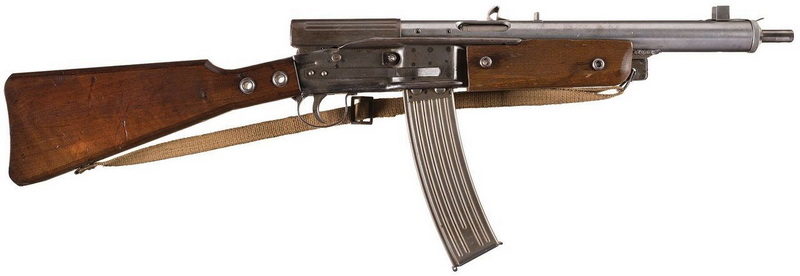 The MP507 was issued with a permanently attached web sling, fastened with nails or screws at the rear. The sling appears to be identical with the late war carrying straps for the gas mask canister. Same width, same friction buckle and coarse webbing, but a lot shorter than the full gas mask canister strap. 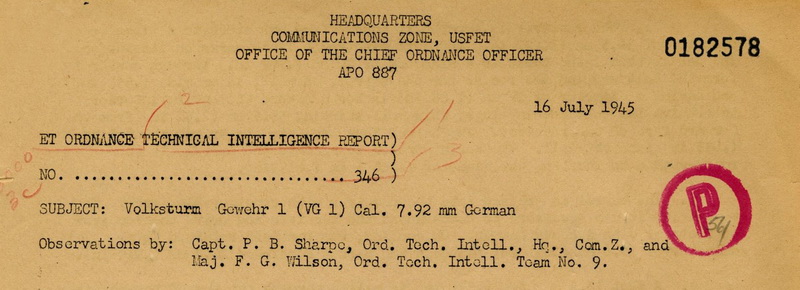  The Volksgewehr 1 pictured above was captured by the US army in the ETO by the end of the war, and was thoroughly studied. A series of pictures of it followed a US report dated 16 July 1945. 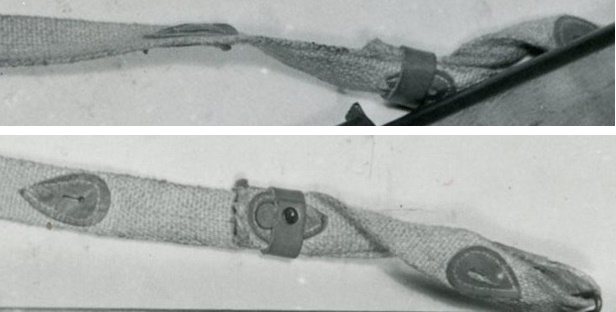 The sling was made of very coarse webbing, and had 4 or 5 teardrop-shaped leather discs sewn on at both sides at the forward end as buttonhole-reinforcement. The parts appear to have been hand cut. I assume a double headed button of steel would have held the sling together, but that part appears to be missing. 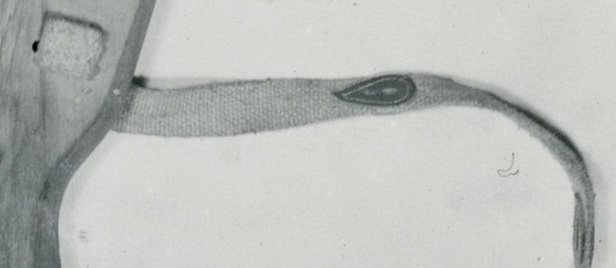 The rear end has a row of three similar leather discs, and the end has simply been folded over and sewn together to act as a stopper. The whole sling is of very basic workmanship and was probably made by the cottage industry set up at the end of the war as the front lines shrank. It does not appear to be "industrially" made. A sling of this quality and this late in the war would certainly not sport a single stamp in my opinion. The copy sling pictured further up bears a slight resemblance as it has 3 leather discs in one end, but that is the only similarity. The K98k sling in manuals The leather sling for the K98k is of course also described and pictured in the manuals supplied with the rifles. 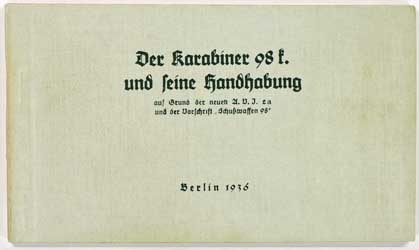 Here is a interesting one which appears to be one of the first manuals for the K98k 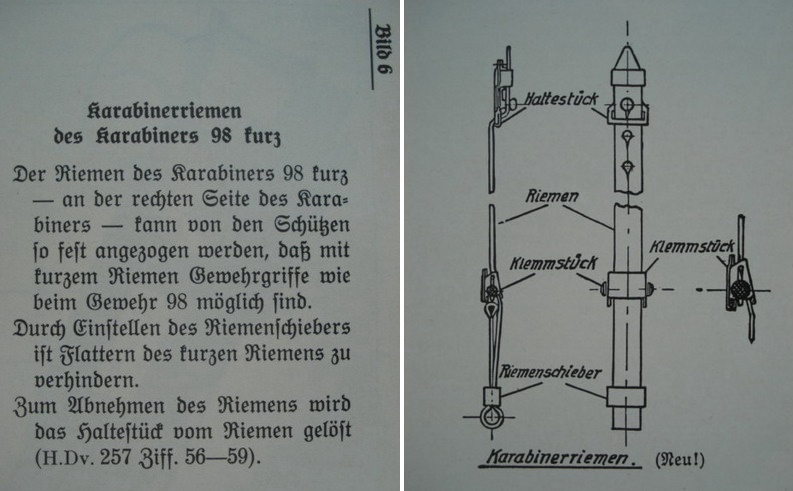 It has a section on the sling, with the correct names. Note that this 1936 publication states the "Karabinerriemen" as "Neu." (New.). Also note the correct name for the keeper/stopper/button/Frosch as "Haltestück". In this handbook from 1944 for the German Police it is called both a "Haltestück" and "Riemenplatte mit Knopf" 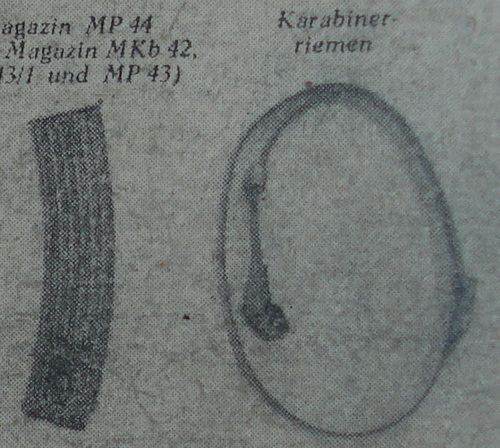 Here is a page for the booklet supplied with the MP44, stating that the correct sling is a Karabinerriemen Care and maintenance From a collector's viewpoint the light, brown color should be preserved. Once the sling gets darker it is on a one-way street with no return and a lower collector value. There are only two ways in my book to maintain leather. It can be wiped down and preserved as it is, or you have to use saddle soap (KIWI brand). If the sling is very dirty and oily a good rub with saddle soap will make it better, as it will remove some of the grease, oil and dirt. If the sling is light in appearance, the saddle soap will darken it, so think before you act. In my experience there is no way of removing all the gun oil from soaked slings to make them look new again. If your sling has that dry feeling but isn't cracking, just be happy. That is the way I prefer them. If it has dried out and cracks, mostly due to bad storage, the only way to improve it is by using saddle soap or some kind of grease. The cracked parts will never heal though, as the cracked part is "dead". Summary I hope you have enjoyed these pages about the Mauser K98k slings. If something is still unclear, or if you have further questions you can contact me through the "Contact information" link that is located below. If you wonder how to mount the sling on your rifle, check out my Mounting instructions for Dummies. |
| Home | For sale | Site map | Contact information | Guest book | Mauser slings page 1 | Mauser slings page 2 | Mounting instructions |